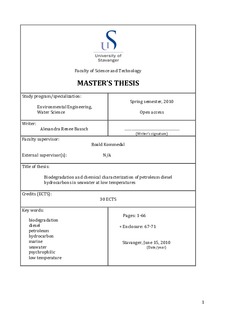| dc.contributor.advisor | Kommedal, Roald | |
| dc.contributor.author | Bausch, Alexandra Renee | |
| dc.date.accessioned | 2017-12-12T08:38:07Z | |
| dc.date.available | 2017-12-12T08:38:07Z | |
| dc.date.issued | 2010-06 | |
| dc.identifier.uri | http://hdl.handle.net/11250/2470528 | |
| dc.description | Master's thesis in Environmental engineering | nb_NO |
| dc.description.abstract | Petroleum hydrocarbons are a major source of marine contamination. Biodegradation, which is fundamental for the natural attenuation of these hydrocarbons in nature, involves mineralization or transformation of organic compounds by autochthonous microorganism communities. Various limiting factors characteristic of the petroleum, the external environment, and the microbial community determine the fate of oil (e.g., diesel) in the marine environment. Here, laboratory biodegradation experiments were conducted to investigate the aerobic biodegradation and chemical utilization of petroleum diesel hydrocarbons in seawater at four different temperatures: 15, 8, 4, and 0.5°C. Diesel, the sole carbon source, was immobilized on Fluortex adsorbents in closed-bottle microcosms. Biological oxygen demand was monitored via respirometric measurements over a period of 64 days. Designated test flasks were removed from incubation at various times for extraction, bacterial sampling, or total organic carbon analysis. Chemical degradation of the individual diesel hydrocarbons was monitored via liquid-liquid extraction in pentane, evaporation, and gas chromatography analysis. Based on chemical and bacterial analyses of diesel biodegradation, it was determined that incubation temperature affected petroleum diesel biodegradation. Rates of diesel biodegradation were enhanced at 15°C and retarded at 0.5°C. According to calculated half-life values for diesel hydrocarbon constituents, the rates of utilization were directly proportional to temperature and inversely proportional to hydrocarbon chain length. The method for chemical analysis caused significant evaporative losses of volatile hydrocarbon diesel fractions (64%). For both biodegradation and chemical utilization, the final extent of degradation was not affected by temperature. Future research is recommended to better understand biodegradation in natural systems. | nb_NO |
| dc.language.iso | eng | nb_NO |
| dc.publisher | University of Stavanger, Norway | nb_NO |
| dc.relation.ispartofseries | Masteroppgave/UIS-TN-IMN/2010; | |
| dc.rights | Navngivelse 4.0 Internasjonal | * |
| dc.rights.uri | http://creativecommons.org/licenses/by/4.0/deed.no | * |
| dc.subject | environmental engineering | nb_NO |
| dc.subject | teknisk miljøvern | nb_NO |
| dc.subject | biodegradation | nb_NO |
| dc.subject | diesel | nb_NO |
| dc.subject | petroleum | nb_NO |
| dc.subject | disel | nb_NO |
| dc.subject | hydrocarbon | nb_NO |
| dc.subject | sjøvann | nb_NO |
| dc.subject | psychrophilic | nb_NO |
| dc.title | Biodegradation and chemical characterization of petroleum diesel hydrocarbons in seawater at low temperatures | nb_NO |
| dc.type | Master thesis | nb_NO |
| dc.subject.nsi | VDP::Teknologi: 500::Miljøteknologi: 610 | nb_NO |

